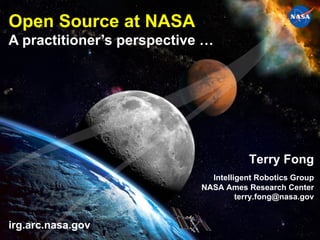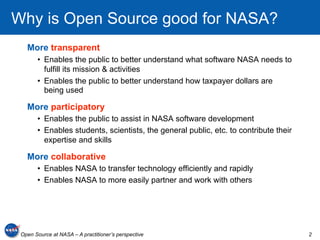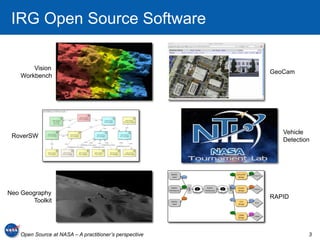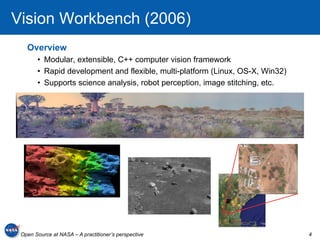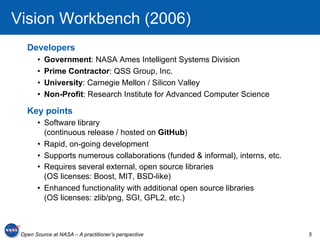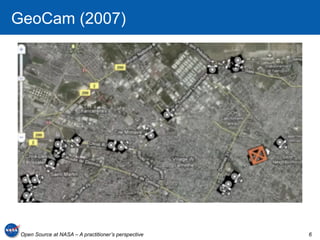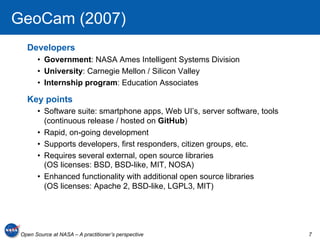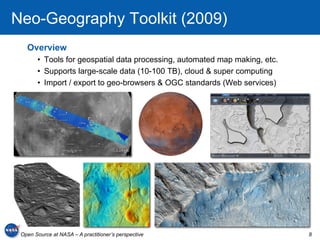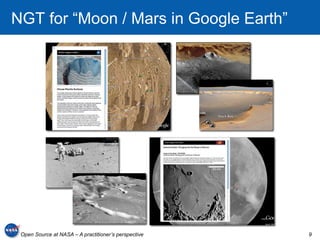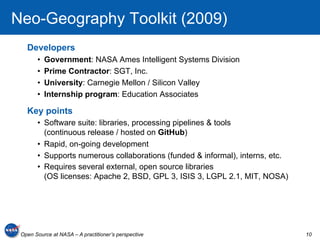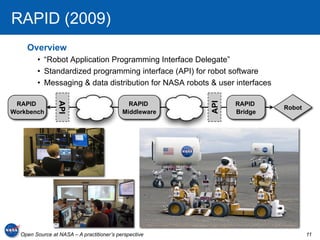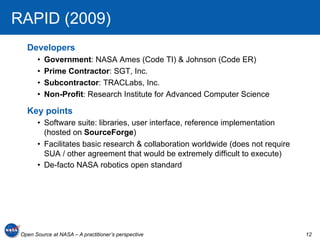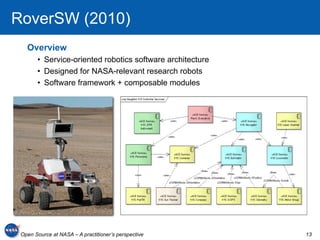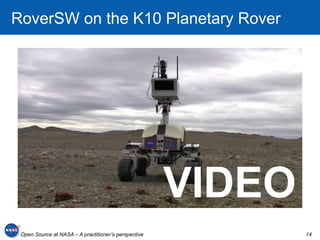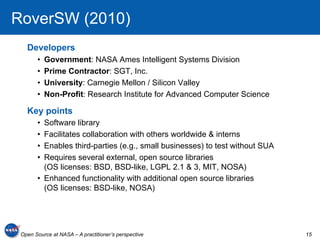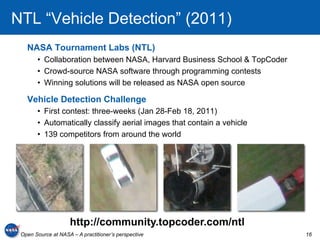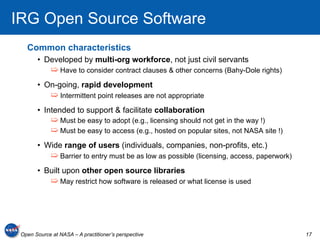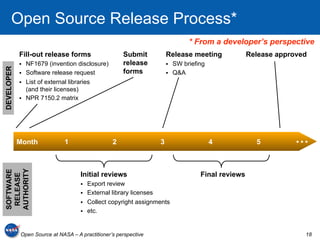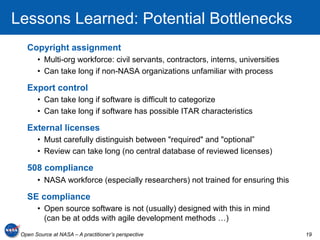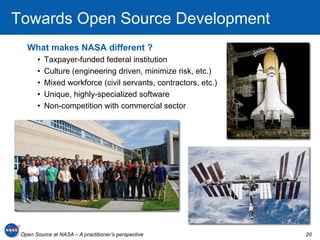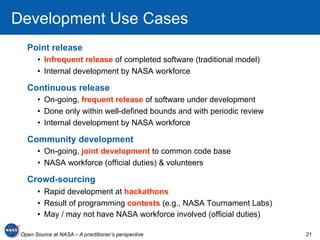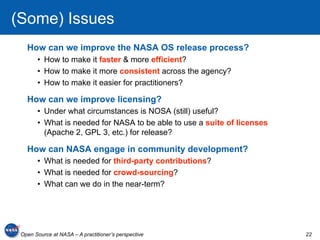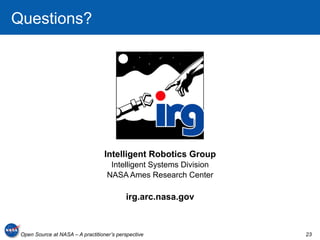2011 NASA Open Source Summit - Terry Fong
- 1. Open Source at NASA A practitionerâs perspective âĶ Terry Fong Intelligent Robotics Group NASA Ames Research Center terry.fong@nasa.gov irg.arc.nasa.gov Open Source at NASA â A practitionerâs perspective 1
- 2. Why is Open Source good for NASA? More transparent âĒâŊ Enables the public to better understand what software NASA needs to fulfill its mission & activities âĒâŊ Enables the public to better understand how taxpayer dollars are being used More participatory âĒâŊ Enables the public to assist in NASA software development âĒâŊ Enables students, scientists, the general public, etc. to contribute their expertise and skills More collaborative âĒâŊ Enables NASA to transfer technology efficiently and rapidly âĒâŊ Enables NASA to more easily partner and work with others Open Source at NASA â A practitionerâs perspective 2
- 3. IRG Open Source Software Vision GeoCam Workbench Vehicle RoverSW Detection Neo Geography RAPID Toolkit Open Source at NASA â A practitionerâs perspective 3
- 4. Vision Workbench (2006) Overview âĒâŊ Modular, extensible, C++ computer vision framework âĒâŊ Rapid development and flexible, multi-platform (Linux, OS-X, Win32) âĒâŊ Supports science analysis, robot perception, image stitching, etc. Open Source at NASA â A practitionerâs perspective 4
- 5. Vision Workbench (2006) Developers âĒâŊ Government: NASA Ames Intelligent Systems Division âĒâŊ Prime Contractor: QSS Group, Inc. âĒâŊ University: Carnegie Mellon / Silicon Valley âĒâŊ Non-Profit: Research Institute for Advanced Computer Science Key points âĒâŊ Software library (continuous release / hosted on GitHub) âĒâŊ Rapid, on-going development âĒâŊ Supports numerous collaborations (funded & informal), interns, etc. âĒâŊ Requires several external, open source libraries (OS licenses: Boost, MIT, BSD-like) âĒâŊ Enhanced functionality with additional open source libraries (OS licenses: zlib/png, SGI, GPL2, etc.) Open Source at NASA â A practitionerâs perspective 5
- 6. GeoCam (2007) Open Source at NASA â A practitionerâs perspective 6
- 7. GeoCam (2007) Developers âĒâŊ Government: NASA Ames Intelligent Systems Division âĒâŊ University: Carnegie Mellon / Silicon Valley âĒâŊ Internship program: Education Associates Key points âĒâŊ Software suite: smartphone apps, Web UIâs, server software, tools (continuous release / hosted on GitHub) âĒâŊ Rapid, on-going development âĒâŊ Supports developers, first responders, citizen groups, etc. âĒâŊ Requires several external, open source libraries (OS licenses: BSD, BSD-like, MIT, NOSA) âĒâŊ Enhanced functionality with additional open source libraries (OS licenses: Apache 2, BSD-like, LGPL3, MIT) Open Source at NASA â A practitionerâs perspective 7
- 8. Neo-Geography Toolkit (2009) Overview âĒâŊ Tools for geospatial data processing, automated map making, etc. âĒâŊ Supports large-scale data (10-100 TB), cloud & super computing âĒâŊ Import / export to geo-browsers & OGC standards (Web services) Open Source at NASA â A practitionerâs perspective 8
- 9. NGT for âMoon / Mars in Google Earthâ Open Source at NASA â A practitionerâs perspective 9
- 10. Neo-Geography Toolkit (2009) Developers âĒâŊ Government: NASA Ames Intelligent Systems Division âĒâŊ Prime Contractor: SGT, Inc. âĒâŊ University: Carnegie Mellon / Silicon Valley âĒâŊ Internship program: Education Associates Key points âĒâŊ Software suite: libraries, processing pipelines & tools (continuous release / hosted on GitHub) âĒâŊ Rapid, on-going development âĒâŊ Supports numerous collaborations (funded & informal), interns, etc. âĒâŊ Requires several external, open source libraries (OS licenses: Apache 2, BSD, GPL 3, ISIS 3, LGPL 2.1, MIT, NOSA) Open Source at NASA â A practitionerâs perspective 10
- 11. RAPID (2009) Overview âĒâŊ âRobot Application Programming Interface Delegateâ âĒâŊ Standardized programming interface (API) for robot software âĒâŊ Messaging & data distribution for NASA robots & user interfaces RAPID RAPID RAPID API API Robot Workbench Middleware Bridge Open Source at NASA â A practitionerâs perspective 11
- 12. RAPID (2009) Developers âĒâŊ Government: NASA Ames (Code TI) & Johnson (Code ER) âĒâŊ Prime Contractor: SGT, Inc. âĒâŊ Subcontractor: TRACLabs, Inc. âĒâŊ Non-Profit: Research Institute for Advanced Computer Science Key points âĒâŊ Software suite: libraries, user interface, reference implementation (hosted on SourceForge) âĒâŊ Facilitates basic research & collaboration worldwide (does not require SUA / other agreement that would be extremely difficult to execute) âĒâŊ De-facto NASA robotics open standard Open Source at NASA â A practitionerâs perspective 12
- 13. RoverSW (2010) Overview âĒâŊ Service-oriented robotics software architecture âĒâŊ Designed for NASA-relevant research robots âĒâŊ Software framework + composable modules Open Source at NASA â A practitionerâs perspective 13
- 14. RoverSW on the K10 Planetary Rover VIDEO Open Source at NASA â A practitionerâs perspective 14
- 15. RoverSW (2010) Developers âĒâŊ Government: NASA Ames Intelligent Systems Division âĒâŊ Prime Contractor: SGT, Inc. âĒâŊ University: Carnegie Mellon / Silicon Valley âĒâŊ Non-Profit: Research Institute for Advanced Computer Science Key points âĒâŊ Software library âĒâŊ Facilitates collaboration with others worldwide & interns âĒâŊ Enables third-parties (e.g., small businesses) to test without SUA âĒâŊ Requires several external, open source libraries (OS licenses: BSD, BSD-like, LGPL 2.1 & 3, MIT, NOSA) âĒâŊ Enhanced functionality with additional open source libraries (OS licenses: BSD-like, NOSA) Open Source at NASA â A practitionerâs perspective 15
- 16. NTL âVehicle Detectionâ (2011) NASA Tournament Labs (NTL) âĒâŊ Collaboration between NASA, Harvard Business School & TopCoder âĒâŊ Crowd-source NASA software through programming contests âĒâŊ Winning solutions will be released as NASA open source Vehicle Detection Challenge âĒâŊ First contest: three-weeks (Jan 28-Feb 18, 2011) âĒâŊ Automatically classify aerial images that contain a vehicle âĒâŊ 139 competitors from around the world http://community.topcoder.com/ntl Open Source at NASA â A practitionerâs perspective 16
- 17. IRG Open Source Software Common characteristics âĒâŊ Developed by multi-org workforce, not just civil servants âŊâŊ Have to consider contract clauses & other concerns (Bahy-Dole rights) âĒâŊ On-going, rapid development âŊâŊ Intermittent point releases are not appropriate âĒâŊ Intended to support & facilitate collaboration âŊâŊ Must be easy to adopt (e.g., licensing should not get in the way !) âŊâŊ Must be easy to access (e.g., hosted on popular sites, not NASA site !) âĒâŊ Wide range of users (individuals, companies, non-profits, etc.) âŊâŊ Barrier to entry must be as low as possible (licensing, access, paperwork) âĒâŊ Built upon other open source libraries âŊâŊ May restrict how software is released or what license is used Open Source at NASA â A practitionerâs perspective 17
- 18. Open Source Release Process* * From a developerâs perspective Fill-out release forms Submit Release meeting Release approved ï§âŊ NF1679 (invention disclosure) release ï§âŊ SW briefing DEVELOPER ï§âŊ Software release request forms ï§âŊ Q&A ï§âŊ List of external libraries (and their licenses) ï§âŊ NPR 7150.2 matrix Month 1 2 3 4 5 âĒâĒâĒ AUTHORITY SOFTWARE Initial reviews Final reviews RELEASE ï§âŊ Export review ï§âŊ External library licenses ï§âŊ Collect copyright assignments ï§âŊ etc. Open Source at NASA â A practitionerâs perspective 18
- 19. Lessons Learned: Potential Bottlenecks Copyright assignment âĒâŊ Multi-org workforce: civil servants, contractors, interns, universities âĒâŊ Can take long if non-NASA organizations unfamiliar with process Export control âĒâŊ Can take long if software is difficult to categorize âĒâŊ Can take long if software has possible ITAR characteristics External licenses âĒâŊ Must carefully distinguish between "required" and "optionalâ âĒâŊ Review can take long (no central database of reviewed licenses) 508 compliance âĒâŊ NASA workforce (especially researchers) not trained for ensuring this SE compliance âĒâŊ Open source software is not (usually) designed with this in mind (can be at odds with agile development methods âĶ) Open Source at NASA â A practitionerâs perspective 19
- 20. Towards Open Source Development What makes NASA different ? âĒâŊ Taxpayer-funded federal institution âĒâŊ Culture (engineering driven, minimize risk, etc.) âĒâŊ Mixed workforce (civil servants, contractors, etc.) âĒâŊ Unique, highly-specialized software âĒâŊ Non-competition with commercial sector Open Source at NASA â A practitionerâs perspective 20
- 21. Development Use Cases Point release âĒâŊ Infrequent release of completed software (traditional model) âĒâŊ Internal development by NASA workforce Continuous release âĒâŊ On-going, frequent release of software under development âĒâŊ Done only within well-defined bounds and with periodic review âĒâŊ Internal development by NASA workforce Community development âĒâŊ On-going, joint development to common code base âĒâŊ NASA workforce (official duties) & volunteers Crowd-sourcing âĒâŊ Rapid development at hackathons âĒâŊ Result of programming contests (e.g., NASA Tournament Labs) âĒâŊ May / may not have NASA workforce involved (official duties) Open Source at NASA â A practitionerâs perspective 21
- 22. (Some) Issues How can we improve the NASA OS release process? âĒâŊ How to make it faster & more efficient? âĒâŊ How to make it more consistent across the agency? âĒâŊ How to make it easier for practitioners? How can we improve licensing? âĒâŊ Under what circumstances is NOSA (still) useful? âĒâŊ What is needed for NASA to be able to use a suite of licenses (Apache 2, GPL 3, etc.) for release? How can NASA engage in community development? âĒâŊ What is needed for third-party contributions? âĒâŊ What is needed for crowd-sourcing? âĒâŊ What can we do in the near-term? Open Source at NASA â A practitionerâs perspective 22
- 23. Questions? Intelligent Robotics Group Intelligent Systems Division NASA Ames Research Center irg.arc.nasa.gov Open Source at NASA â A practitionerâs perspective 23

